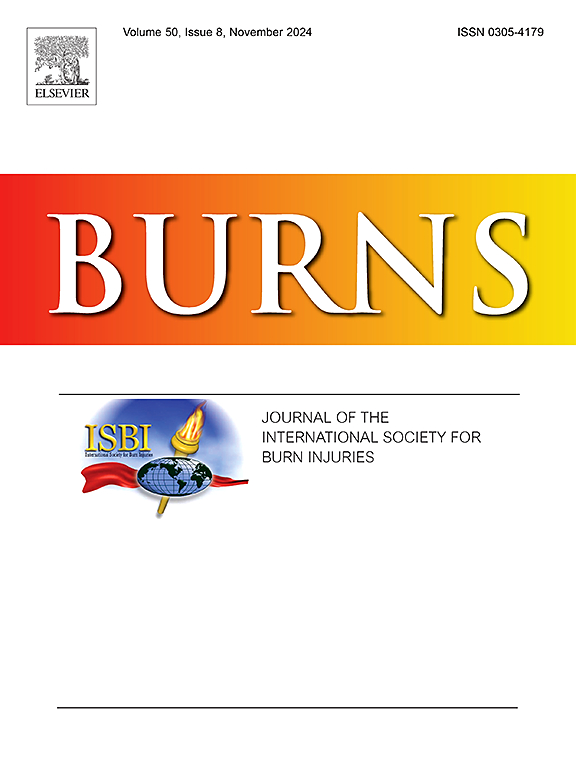Does trauma center designation impact management, complications, and outcomes in burn patients? A National Trauma Data Bank analysis
IF 2.9
3区 医学
Q2 CRITICAL CARE MEDICINE
引用次数: 0
Abstract
Background
Burn injuries, particularly those involving large total body surface area (TBSA), present significant challenges due to fluid shifts, increased metabolic demands, and heightened susceptibility to complications. Trauma center designation, ranging from Level 1 (highest acuity) to Level 3, reflects differences in resources, expertise, and care protocols, which may influence patient outcomes. This study evaluates the impact of trauma center designation on transfusion practices, complications, and mortality among burn patients.
Methods
The Trauma Quality Improvement Program (TQIP) database (2017–2022) was queried to identify burn patients by ICD-9/10 codes. Patients were categorized based on trauma center designation: Level 1 versus non-Level 1 (Levels 2 and 3). Outcomes analyzed included transfusion practices (e.g., packed red blood cells, plasma, platelets), inpatient complications, and mortality. Multivariable logistic regression was performed, adjusted for age, gender, %TBSA, inhalation injury, and Injury Severity Score (ISS). Subgroup analysis was performed for patients with burns > 20 % TBSA.
Results
Among 72,474 burn patients, 47 % were treated at Level 1 centers. Patients at Level 1 centers presented with higher injury severity and had significantly higher rates of complications, including respiratory failure, sepsis, and surgical site infections. Despite the higher complication rates, Level 1 centers demonstrated significantly lower mortality compared to non-Level 1 centers (adjusted OR=0.46, 95 % CI 0.25–0.83, p = 0.011). Transfusion practices did not differ significantly between center levels after adjustment. In patients with burns > 20 % TBSA, Level 1 centers maintained lower mortality rates (adjusted OR=0.83, 95 % CI 0.79–0.88, p < 0.001).
Conclusion
Trauma center designation is associated with significant differences in burn outcomes. Level 1 centers, despite managing more severe cases, demonstrate lower mortality, emphasizing the importance of specialized care for burn patients. Standardizing burn care protocols and optimizing transfer practices may further improve outcomes for this high-acuity population.
创伤中心的指定对烧伤患者的管理、并发症和预后有影响吗?国家创伤数据库分析
背景:烧伤,特别是涉及大体表面积(TBSA)的烧伤,由于体液转移、代谢需求增加和对并发症的易感性增加,带来了重大挑战。创伤中心的等级从1级(最高视力)到3级,反映了资源、专业知识和护理方案的差异,这可能会影响患者的预后。本研究评估创伤中心指定对烧伤患者输血操作、并发症和死亡率的影响。方法查询创伤质量改善计划(TQIP)数据库(2017-2022),采用ICD-9/10编码识别烧伤患者。患者根据创伤中心的指定进行分类:1级与非1级(2级和3级)。结果分析包括输血操作(如红细胞、血浆、血小板堆积)、住院并发症和死亡率。进行多变量logistic回归,调整年龄、性别、TBSA %、吸入性损伤和损伤严重程度评分(ISS)。对烧伤>; 20 % TBSA患者进行亚组分析。结果72,474例烧伤患者中,47% %在一级中心治疗。1级中心的患者损伤严重程度更高,并发症发生率明显更高,包括呼吸衰竭、败血症和手术部位感染。尽管并发症发生率较高,但与非一级中心相比,一级中心的死亡率显著降低(调整后OR=0.46, 95 % CI 0.25-0.83, p = 0.011)。输血实践在调整后的中心水平之间没有显著差异。在烧伤>; 20 % TBSA患者中,1级中心保持较低的死亡率(调整后OR=0.83, 95 % CI 0.79-0.88, p <; 0.001)。结论创伤中心的指定与烧伤预后的显著差异有关。一级中心,尽管管理更严重的病例,显示较低的死亡率,强调对烧伤患者的专业护理的重要性。标准化烧伤护理方案和优化转院实践可以进一步改善这一高敏度人群的预后。
本文章由计算机程序翻译,如有差异,请以英文原文为准。
求助全文
约1分钟内获得全文
求助全文
来源期刊

Burns
医学-皮肤病学
CiteScore
4.50
自引率
18.50%
发文量
304
审稿时长
72 days
期刊介绍:
Burns aims to foster the exchange of information among all engaged in preventing and treating the effects of burns. The journal focuses on clinical, scientific and social aspects of these injuries and covers the prevention of the injury, the epidemiology of such injuries and all aspects of treatment including development of new techniques and technologies and verification of existing ones. Regular features include clinical and scientific papers, state of the art reviews and descriptions of burn-care in practice.
Topics covered by Burns include: the effects of smoke on man and animals, their tissues and cells; the responses to and treatment of patients and animals with chemical injuries to the skin; the biological and clinical effects of cold injuries; surgical techniques which are, or may be relevant to the treatment of burned patients during the acute or reconstructive phase following injury; well controlled laboratory studies of the effectiveness of anti-microbial agents on infection and new materials on scarring and healing; inflammatory responses to injury, effectiveness of related agents and other compounds used to modify the physiological and cellular responses to the injury; experimental studies of burns and the outcome of burn wound healing; regenerative medicine concerning the skin.
 求助内容:
求助内容: 应助结果提醒方式:
应助结果提醒方式:


